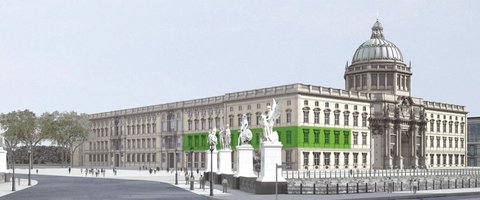
Humboldt Laboratory
The Humboldt Laboratory is...
...open: The Humboldt Laboratory acts as the university’s open laboratory. It offers access to an immense spectrum of knowledge to visitors of all ages, from seasoned experts to laypersons without scientific backgrounds. Research processes can be experienced up close in the Humboldt Laboratory, a place where direct discussions with specialists can take place.
...current: The Humboldt Laboratory works on issues connected to current research at the Humboldt-Universität and its cooperation partners. Its programme provides a space to present and discuss the latest findings, making it possible to respond quickly to controversial issues.
...intercultural: The Humboldt Laboratory makes the university visible as a space for intercultural contact and activity. It does not just conduct research on cultures but – first and foremost – with cultures and international actors, thus combining interdisciplinary competence with intercultural competence. It is a local space with a global character.
...interactive: The Humboldt Laboratory communicates and produces knowledge. Through a range of activities, from exhibitions to public experiments, it aims to engage its visitors and to inspire them to form new ideas of their own.
...visionary: Together with the public, the Humboldt Laboratory tests new forms of learning and teaching, and will reintegrate successful models into study and research. In this way, the Humboldt Laboratory contributes to shaping the future of the university in the 21st century.
Formats
The Humboldt Laboratory will constantly seek new formats to present its work – formats that promote dialogue and that do justice to the objects of its research and the actors concerned: it uses exhibitions, public seminars and workshops, experiments, performances, and serious games to communicate its research.
Tradition
The Humboldt Laboratory continues the shared history linking the Humboldt-Universität and Berlin Palace: large parts of the collections in the chamber of curiosities in the Berlin Palace were transferred to the Humboldt-Universität 200 years ago on its founding. From the university’s beginnings, they provided a foundation for its research. Today, the Humboldt-Universität holds more than 40 scientific collections. Between 1921 and 1932, the palace was also used by the university as a scientific laboratory and was the site of the Institute of Psychology. With the Humboldt Laboratory, the Humboldt-Universität continues this double tradition: the Living Thought Laboratory makes scientific collections virtually accessible; the Humboldt-Universität’s Sound Archive, a unique collection of multilingual sound recordings from the early 20th century, is being relocated to the Humboldt Forum and will be opened to researchers and visitors.
Organisation
The Humboldt Laboratory forms part of the Hermann von Helmholtz Centre for Cultural Techniques (HZK) at the Humboldt-Universität zu Berlin and builds on the work of the Excellence Cluster Image Knowledge Gestaltung – an interdisciplinary research laboratory for the humanities, the natural and engineering sciences, medicine, and the creative disciplines design and architecture. The Humboldt Laboratory team can draw on the Cluster’s expertise, on more than 30,000 students and over 2,500 researchers at the Humboldt-Universität, the Berlin research landscape, and its international cooperation partners. It will make every visit a new experience.

